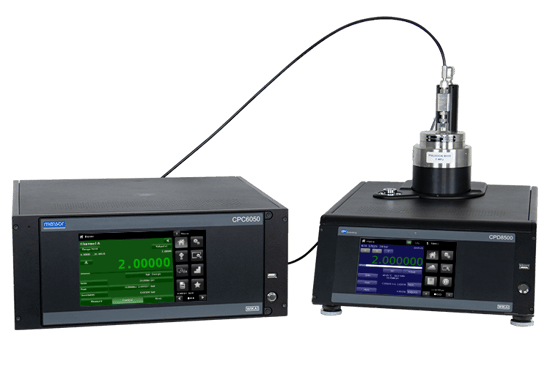Many steps in calibrating an instrument - whether temperature or pressure - don’t actually involve calibration. Setting up weights, heating or cooling baths and switching between multiple reference points take up time and manpower.
A more efficient solution for many calibration applications involves automating this process. The calibration of temperature and pressure instruments can be automated using more sophisticated instruments with the ability to control reference values and maneuver between multiple calibration points automatically.
Automating Pressure Calibrations
For pressure calibration, this can be accomplished with an automatic pressure controller, such as the CPC6050, and an electronic primary standard, such as the CPD8500 Digital Deadweight Tester. All that’s needed is the device under test, a digital deadweight tester and an automatic pressure controller.
 A digital deadweight tester can measure multiple values precisely, which is why it's used as a reference standard in calibration. Digital deadweight testers eliminate the need for loading bulky mass sets on top, however, they can’t generate pressure on their own. They still require a pressure source as input to read that pressure accurately without worrying about fluctuations in a pressure line. This is where an automated pressure controller comes in. A pressure controller with the capability of initiating pressure generation and steady regulation of multiple points can streamline the calibration process.
A digital deadweight tester can measure multiple values precisely, which is why it's used as a reference standard in calibration. Digital deadweight testers eliminate the need for loading bulky mass sets on top, however, they can’t generate pressure on their own. They still require a pressure source as input to read that pressure accurately without worrying about fluctuations in a pressure line. This is where an automated pressure controller comes in. A pressure controller with the capability of initiating pressure generation and steady regulation of multiple points can streamline the calibration process.
To calibrate a pressure instrument automatically, connect the device under test to the digital deadweight tester and connect the deadweight tester to an automatic pressure controller. A technician can set the calibration points on the pressure controller and then allow the instrument to control the pressure generated by the digital deadweight tester to calibrate the device under test. These devices seamlessly communicate the data to a computer, which eliminates the need for constant supervision. Automating the calibration process reduces time and energy spent in the calibration lab switching masses, setting points and logging data, while still maintaining a high level of accuracy.
Automating Temperature Calibrations
The process is similar for temperature calibration. To perform any temperature calibration, you need three devices - one to test, one to accurately control the temperature and one to accurately read the temperature. This process can be automated through a dry-well calibrator with electronic temperature control, such as a CTD9100, partnered with a multi-functional precision thermometer with a digital interface that can display multiple readings, such as the CTR3000.
The dry-well calibrator controls the temperature within the drum and sends a reading to the precision thermometer, which can take readings of multiple temperature probes at once. The precision thermometer can measure and store multiple data points automatically. The only thing a calibration technician must do is initiate the process by inserting the device under test into the dry-well calibrator, connecting the calibrator to the thermometer and letting the instruments reach their temperature points before logging the data.
Conclusion
There are multiple benefits to be had from automated calibrations. In streamlining the process, calibration technicians are no longer chained to the lab and are able to maximize the number of calibrations they perform, have opportunities to perform other duties or even take the occasional coffee break.
Related Reading:



